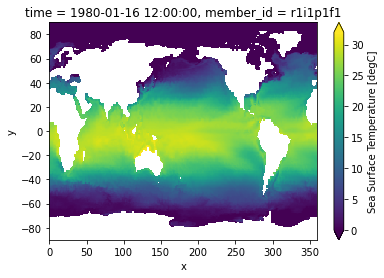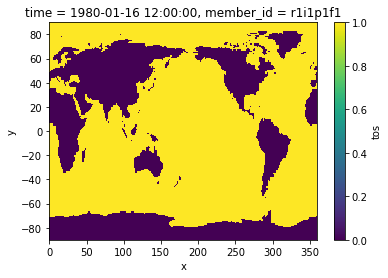CMIP6: NOAA-GFDL CM4¶
Here is a quick example of how to use :py:class:Tracker.track to detect and track marine heatwaves from the Geophysical Fluid Dynamics Global Climate Model, CM4.
First import numpy, xarray, matplotlib, intake, cmip6_preprocessing, ocetrac, and dask:
[1]:
import numpy as np
import xarray as xr
import matplotlib.pyplot as plt
from matplotlib.colors import ListedColormap
import intake
from cmip6_preprocessing.preprocessing import combined_preprocessing
import ocetrac
# libraries for dask gateway
from dask_gateway import Gateway
from dask.distributed import Client
from dask import delayed
import dask
dask.config.set({"array.slicing.split_large_chunks": False})
[1]:
<dask.config.set at 0x7f2a58a59fd0>
Start a dask kubernetes cluster:
[2]:
gateway = Gateway()
cluster = gateway.new_cluster()
cluster.adapt(minimum=1, maximum=75)
client = Client(cluster)
cluster
☝️ Don’t forget to click the link above to view the scheduler dashboard!
An ESM collection for CMIP6 Zarr data resides on Pangeo’s Google Storage.¶
[3]:
col = intake.open_esm_datastore("https://storage.googleapis.com/cmip6/pangeo-cmip6.json")
# create a query dictionary
query = col.search(experiment_id=['historical'], # all forcing of the recent past
table_id='Omon', # ocean monthly data
source_id='GFDL-CM4', # GFDL Climate Model 4
variable_id=['tos'], # temperature ocean surface
grid_label='gr', # regridded data on target grid
)
query
pangeo-cmip6 catalog with 1 dataset(s) from 1 asset(s):
| unique | |
|---|---|
| activity_id | 1 |
| institution_id | 1 |
| source_id | 1 |
| experiment_id | 1 |
| member_id | 1 |
| table_id | 1 |
| variable_id | 1 |
| grid_label | 1 |
| zstore | 1 |
| dcpp_init_year | 0 |
| version | 1 |
[4]:
ds = query.to_dataset_dict(zarr_kwargs={'consolidated': True},
storage_options={'token': 'anon'},
preprocess=combined_preprocessing,
)
tos = ds['CMIP.NOAA-GFDL.GFDL-CM4.historical.Omon.gr'].tos.isel(member_id=0).sel(time=slice('1980', '2014'))
tos
--> The keys in the returned dictionary of datasets are constructed as follows:
'activity_id.institution_id.source_id.experiment_id.table_id.grid_label'
[4]:
<xarray.DataArray 'tos' (time: 420, y: 180, x: 360)>
dask.array<getitem, shape=(420, 180, 360), dtype=float32, chunksize=(120, 180, 360), chunktype=numpy.ndarray>
Coordinates:
* y (y) float64 -89.5 -88.5 -87.5 -86.5 -85.5 ... 86.5 87.5 88.5 89.5
* x (x) float64 0.5 1.5 2.5 3.5 4.5 ... 355.5 356.5 357.5 358.5 359.5
* time (time) object 1980-01-16 12:00:00 ... 2014-12-16 12:00:00
lon (x, y) float64 0.5 0.5 0.5 0.5 0.5 ... 359.5 359.5 359.5 359.5
lat (x, y) float64 -89.5 -88.5 -87.5 -86.5 ... 86.5 87.5 88.5 89.5
member_id <U8 'r1i1p1f1'
Attributes:
cell_measures: area: areacello
cell_methods: area: mean where sea time: mean
comment: Model data on the 1x1 grid includes values in all cells f...
interp_method: conserve_order1
long_name: Sea Surface Temperature
original_name: tos
standard_name: sea_surface_temperature
units: degC- time: 420
- y: 180
- x: 360
- dask.array<chunksize=(120, 180, 360), meta=np.ndarray>
Array Chunk Bytes 108.86 MB 31.10 MB Shape (420, 180, 360) (120, 180, 360) Count 56 Tasks 4 Chunks Type float32 numpy.ndarray - y(y)float64-89.5 -88.5 -87.5 ... 88.5 89.5
array([-89.5, -88.5, -87.5, -86.5, -85.5, -84.5, -83.5, -82.5, -81.5, -80.5, -79.5, -78.5, -77.5, -76.5, -75.5, -74.5, -73.5, -72.5, -71.5, -70.5, -69.5, -68.5, -67.5, -66.5, -65.5, -64.5, -63.5, -62.5, -61.5, -60.5, -59.5, -58.5, -57.5, -56.5, -55.5, -54.5, -53.5, -52.5, -51.5, -50.5, -49.5, -48.5, -47.5, -46.5, -45.5, -44.5, -43.5, -42.5, -41.5, -40.5, -39.5, -38.5, -37.5, -36.5, -35.5, -34.5, -33.5, -32.5, -31.5, -30.5, -29.5, -28.5, -27.5, -26.5, -25.5, -24.5, -23.5, -22.5, -21.5, -20.5, -19.5, -18.5, -17.5, -16.5, -15.5, -14.5, -13.5, -12.5, -11.5, -10.5, -9.5, -8.5, -7.5, -6.5, -5.5, -4.5, -3.5, -2.5, -1.5, -0.5, 0.5, 1.5, 2.5, 3.5, 4.5, 5.5, 6.5, 7.5, 8.5, 9.5, 10.5, 11.5, 12.5, 13.5, 14.5, 15.5, 16.5, 17.5, 18.5, 19.5, 20.5, 21.5, 22.5, 23.5, 24.5, 25.5, 26.5, 27.5, 28.5, 29.5, 30.5, 31.5, 32.5, 33.5, 34.5, 35.5, 36.5, 37.5, 38.5, 39.5, 40.5, 41.5, 42.5, 43.5, 44.5, 45.5, 46.5, 47.5, 48.5, 49.5, 50.5, 51.5, 52.5, 53.5, 54.5, 55.5, 56.5, 57.5, 58.5, 59.5, 60.5, 61.5, 62.5, 63.5, 64.5, 65.5, 66.5, 67.5, 68.5, 69.5, 70.5, 71.5, 72.5, 73.5, 74.5, 75.5, 76.5, 77.5, 78.5, 79.5, 80.5, 81.5, 82.5, 83.5, 84.5, 85.5, 86.5, 87.5, 88.5, 89.5]) - x(x)float640.5 1.5 2.5 ... 357.5 358.5 359.5
array([ 0.5, 1.5, 2.5, ..., 357.5, 358.5, 359.5])
- time(time)object1980-01-16 12:00:00 ... 2014-12-...
- axis :
- T
- bounds :
- time_bnds
- calendar_type :
- noleap
- description :
- Temporal mean
- long_name :
- time
- standard_name :
- time
array([cftime.DatetimeNoLeap(1980, 1, 16, 12, 0, 0, 0), cftime.DatetimeNoLeap(1980, 2, 15, 0, 0, 0, 0), cftime.DatetimeNoLeap(1980, 3, 16, 12, 0, 0, 0), ..., cftime.DatetimeNoLeap(2014, 10, 16, 12, 0, 0, 0), cftime.DatetimeNoLeap(2014, 11, 16, 0, 0, 0, 0), cftime.DatetimeNoLeap(2014, 12, 16, 12, 0, 0, 0)], dtype=object) - lon(x, y)float640.5 0.5 0.5 ... 359.5 359.5 359.5
array([[ 0.5, 0.5, 0.5, ..., 0.5, 0.5, 0.5], [ 1.5, 1.5, 1.5, ..., 1.5, 1.5, 1.5], [ 2.5, 2.5, 2.5, ..., 2.5, 2.5, 2.5], ..., [357.5, 357.5, 357.5, ..., 357.5, 357.5, 357.5], [358.5, 358.5, 358.5, ..., 358.5, 358.5, 358.5], [359.5, 359.5, 359.5, ..., 359.5, 359.5, 359.5]]) - lat(x, y)float64-89.5 -88.5 -87.5 ... 88.5 89.5
array([[-89.5, -88.5, -87.5, ..., 87.5, 88.5, 89.5], [-89.5, -88.5, -87.5, ..., 87.5, 88.5, 89.5], [-89.5, -88.5, -87.5, ..., 87.5, 88.5, 89.5], ..., [-89.5, -88.5, -87.5, ..., 87.5, 88.5, 89.5], [-89.5, -88.5, -87.5, ..., 87.5, 88.5, 89.5], [-89.5, -88.5, -87.5, ..., 87.5, 88.5, 89.5]]) - member_id()<U8'r1i1p1f1'
array('r1i1p1f1', dtype='<U8')
- cell_measures :
- area: areacello
- cell_methods :
- area: mean where sea time: mean
- comment :
- Model data on the 1x1 grid includes values in all cells for which any ocean exists on the native grid. For mapping purposes, we recommend using a land mask such as World Ocean Atlas to cover these areas of partial land. For calculating approximate integrals, we recommend multiplying by cell area (areacello).
- interp_method :
- conserve_order1
- long_name :
- Sea Surface Temperature
- original_name :
- tos
- standard_name :
- sea_surface_temperature
- units :
- degC
[5]:
tos.isel(time=0).plot(vmin=0, vmax=32);

Create a binary mask for ocean points:
[6]:
mask_ocean = 1 * np.ones(tos.shape[1:]) * np.isfinite(tos.isel(time=0))
mask_land = 0 * np.ones(tos.shape[1:]) * np.isnan(tos.isel(time=0))
mask = mask_ocean + mask_land
mask.plot()
[6]:
<matplotlib.collections.QuadMesh at 0x7f2a054b6610>

Define anomalies and extreme values¶
We will simply define monthly anomalies by subtracting the monthly climatology averaged across 1980–2014. Anomalies that exceed the monthly 90th percentile will be considered here as extreme.
[7]:
climatology = tos.groupby(tos.time.dt.month).mean()
anomaly = tos.groupby(tos.time.dt.month) - climatology
# Rechunk time dim
if tos.chunks:
tos = tos.chunk({'time': -1})
percentile = .9
threshold = tos.groupby(tos.time.dt.month).quantile(percentile, dim='time', keep_attrs=True, skipna=True)
hot_water = anomaly.groupby(tos.time.dt.month).where(tos.groupby(tos.time.dt.month)>threshold)
/srv/conda/envs/notebook/lib/python3.8/site-packages/xarray/core/indexing.py:1369: PerformanceWarning: Slicing with an out-of-order index is generating 35 times more chunks
return self.array[key]
[8]:
%%time
hot_water.load()
client.close()
CPU times: user 895 ms, sys: 163 ms, total: 1.06 s
Wall time: 1min 31s
The plots below shows sea surface temperature anomalies averaged for the month of January 1980. The right panel only shows the extreme anomalies exceeding the 90th percentile.
[9]:
plt.figure(figsize=(16,3))
ax1 = plt.subplot(121);anomaly.isel(time=0).plot(cmap='RdBu_r')
mask.where(mask==0).plot.contourf(colors='k', add_colorbar=False); ax1.set_aspect('equal');
ax2 = plt.subplot(122); hot_water.isel(time=0).plot(cmap='Reds', vmin=0);
mask.where(mask==0).plot.contourf(colors='k', add_colorbar=False); ax2.set_aspect('equal');
/srv/conda/envs/notebook/lib/python3.8/site-packages/dask/array/numpy_compat.py:40: RuntimeWarning: invalid value encountered in true_divide
x = np.divide(x1, x2, out)

Label and Track Marine Heatwaves¶
Using the extreme SST anomalies only, we use Ocetrac to label and track marine heatwave events.
We need to define two key parameters that can be tuned bases on the resolution of the dataset and distribution of data. The first is radius which represents the number of grid cells defining the width of the structuring element used in the morphological operations (i.e., opening and closing). The second is min_size_quartile that is used as a threshold to subsample the objects accroding the the distribution of object area.
[10]:
%%time
Tracker = ocetrac.Tracker(hot_water, mask, radius=2, min_size_quartile=0.75, timedim = 'time', xdim = 'x', ydim='y', positive=True)
blobs = Tracker.track()
minimum area: 107.0
inital objects identified 15682
final objects tracked 903
CPU times: user 41 s, sys: 1.54 s, total: 42.6 s
Wall time: 42.6 s
Let’s take a look at some of the attributes.¶
There were over 15,500 MHW object detected. After connecting these events in time and eliminating objects smaller than the 75th percentle (equivalent to the area of 107 grid cells), 903 total MHWs are identified between 1980–2014.
[11]:
blobs.attrs
[11]:
{'inital objects identified': 15682,
'final objects tracked': 903,
'radius': 2,
'size quantile threshold': 0.75,
'min area': 107.0,
'percent area reject': 0.17453639541742397,
'percent area accept': 0.8254636045825761}
Plot the labeled marine heatwaves on January 1980 and compare it to the input image of extreme sea surface temperature anomalies.¶
[12]:
maxl = int(np.nanmax(blobs.values))
cm = ListedColormap(np.random.random(size=(maxl, 3)).tolist())
plt.figure(figsize=(16,3))
ax1 = plt.subplot(121);blobs.isel(time=0).plot(cmap= cm)
mask.where(mask==0).plot.contourf(colors='k', add_colorbar=False); ax1.set_aspect('equal')
ax2 = plt.subplot(122); hot_water.isel(time=0).plot(cmap='Reds', vmin=0);
mask.where(mask==0).plot.contourf(colors='k', add_colorbar=False); ax2.set_aspect('equal');
